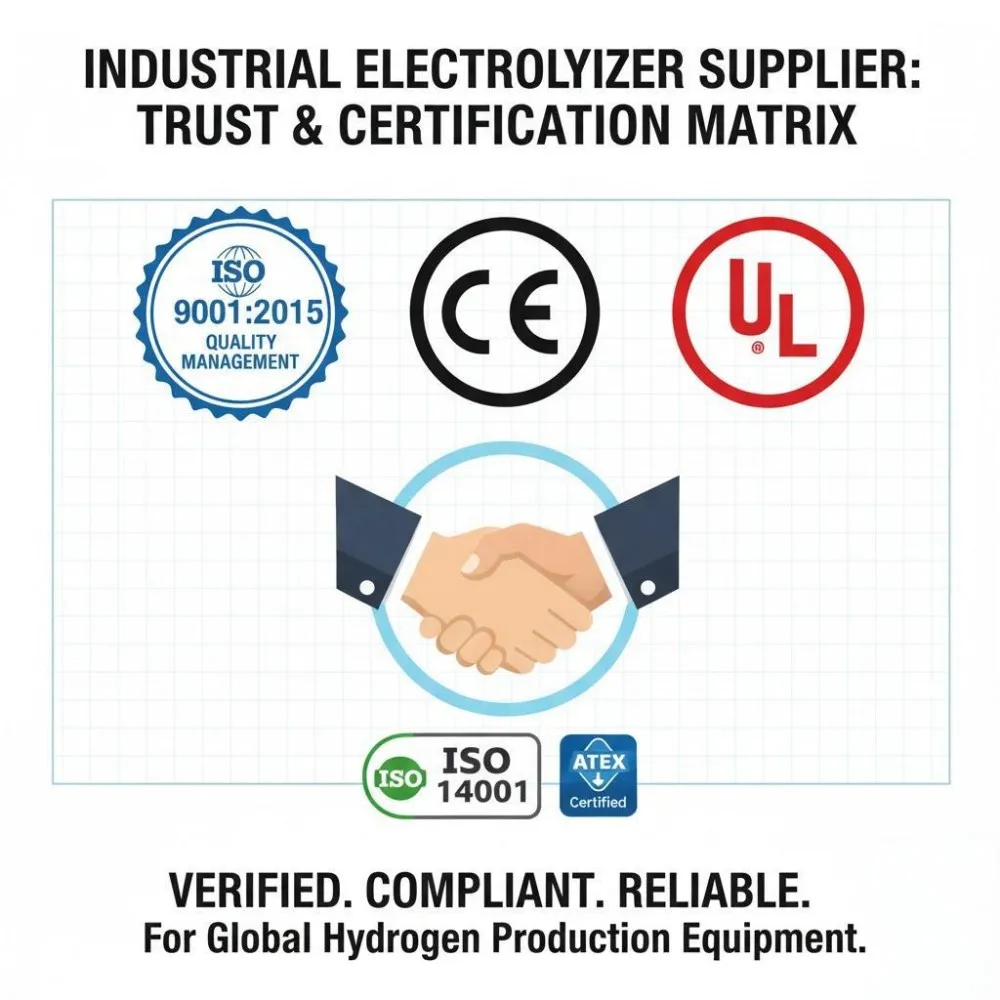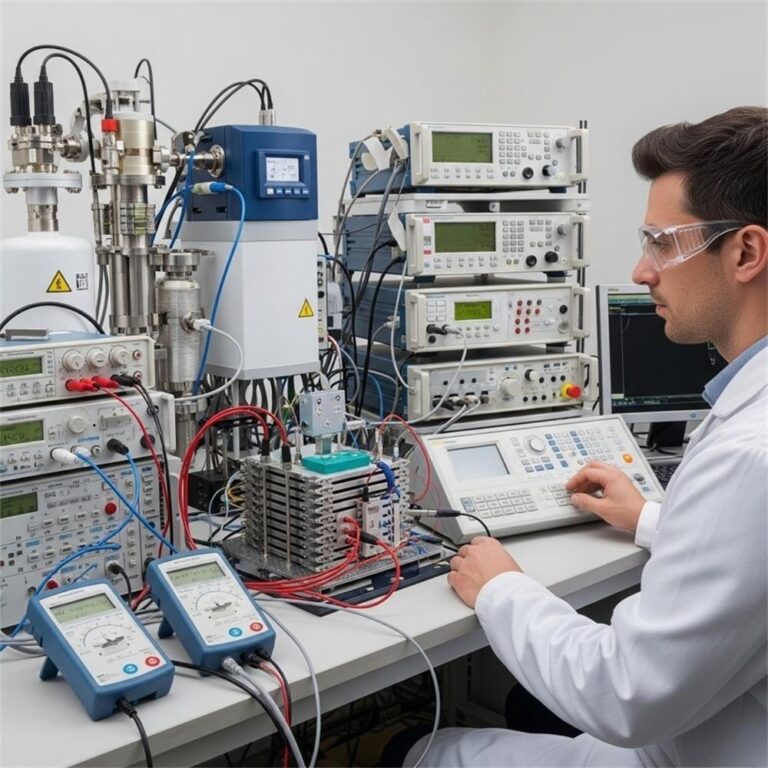Introduction
The sun shines brightly, the wind blows strong — but what happens when they don’t? 🌥️⚡ That’s the challenge renewable energy faces: intermittency. While renewables generate clean power, they can’t guarantee a steady supply around the clock.
This is where innovative energy storage solutions step in, acting as the backbone for a truly sustainable energy grid.
One of the most exciting breakthroughs is the Proton Exchange Membrane (PEM) electrolyzer. These high-efficiency machines split water into hydrogen and oxygen, storing renewable energy in a form that’s clean, versatile, and future-ready. In this post, we’ll dive deep into how PEM electrolyzers work, their advantages, their integration with renewable systems, their efficiency metrics, and what the future holds. Let’s power tomorrow together!
The Fundamentals of Water Electrolysis
At its core, water electrolysis is a simple yet powerful concept. Using an electric current, water (H₂O) is split into its basic elements — hydrogen (H₂) and oxygen (O₂).
The chemical equation is elegantly simple:
2H₂O(l) → 2H₂(g) + O₂(g)
But behind this simplicity lies a world of complex engineering.
There are three primary types of electrolyzers:
- Alkaline Electrolyzers (the oldest and most common),
- Proton Exchange Membrane (PEM) Electrolyzers (modern and flexible),
- Solid Oxide Electrolyzers (still largely experimental).
Each has its niche, but PEM electrolyzers shine especially when quick, responsive, and high-purity hydrogen is required.
Importance of Renewable Electricity
Here’s the real game-changer: when the electricity used for electrolysis comes from solar, wind, or hydro power, the resulting hydrogen is termed “green hydrogen.” 🌱
Thus, PEM electrolyzers serve as a vital link between renewable energy production and reliable energy supply, effectively capturing surplus power that might otherwise be wasted.
PEM Electrolyzers: Advantages and Key Features
Now, what makes PEM electrolyzers the star player among all electrolyzer types? Let’s break it down.
High Efficiency and Purity
- High current density — More hydrogen generated faster.
- Ultra-pure hydrogen output — Essential for fuel cells and industrial applications.
- Lower energy losses compared to older technologies.
Compact and Dynamic Operation
- Rapid start-up and shutdown — They can ramp production up or down almost instantly.
- Compact design — Smaller footprint, flexible installation options.
- Ideal for intermittent sources like solar and wind because of their responsive nature.
Non-Corrosive and Safe
- Solid polymer electrolyte — No need for corrosive liquid chemicals like alkaline systems.
- Lower operating temperatures (around 50–80°C) — Making them safer and more durable for long-term use.
👉 In short: PEM electrolyzers are tailor-made for the renewable energy era.
Seamless Integration with Renewable Energy Systems
Integrating PEM electrolyzers with renewable power is not only possible — it’s already happening around the world.
Direct Coupling vs Grid Connection
- Direct Coupling: PEM electrolyzers connect directly to renewable energy generators like solar panels or wind turbines. This eliminates grid dependence but requires careful control of fluctuating inputs.
- Grid-Connected Systems: These electrolyzers use both grid and renewable sources to optimize hydrogen production.
Real-World Applications
- H2FUTURE Project (Austria): Integrates a PEM electrolyzer with a steel plant powered by renewables.
- REFHYNE (Germany): Europe’s largest PEM electrolyzer project connected to a refinery.
Such projects show that PEM technology is ready to scale.
Hydrogen Storage Techniques
Once hydrogen is produced, it needs safe storage:
- Compressed Gas Storage (under high pressure tanks),
- Liquid Hydrogen Storage (cryogenic temperatures),
- Metal Hydride Storage (hydrogen absorbed into solid materials).
Each method suits different applications, from fueling stations to grid-scale energy backups.
Efficiency Metrics and Performance Analysis
When we talk about energy storage, efficiency is king.
Key KPIs for PEM Electrolyzers
- Energy Efficiency: Typically 60–80% from electrical input to hydrogen output.
- Current Density: Measures how much hydrogen can be produced per unit electrode area.
- Cell Voltage: Lower voltages are better for efficiency.
- Durability: PEM electrolyzers can last 60,000–80,000 operational hours with good maintenance.
PEM vs Other Storage Methods
Compared to batteries:
- Batteries store energy directly but degrade over time.
- Hydrogen stores energy chemically, offering long-term and large-scale storage potential.
- Hydrogen can also power fuel cells, industry, and even vehicles, while batteries are mostly limited to electrical outputs.
Bottom line: For massive, seasonal energy storage — hydrogen wins. 🏆
Future Trends and Innovations
PEM electrolyzers are evolving fast. Here’s what the future holds:
Advanced Materials and Design
- New catalysts (like non-precious metals) aim to reduce costs.
- Better membranes with higher conductivity and stability are under development.
Scale-Up and Cost Reduction
- Gigawatt-scale hydrogen plants are already in planning stages.
- Economies of scale and manufacturing automation are driving down costs rapidly.
New Applications Beyond Storage
- Industrial uses: Hydrogen can replace coal in steelmaking.
- Transportation: Fuel cell vehicles (cars, trucks, trains) use hydrogen efficiently.
- Synthetic fuels: Hydrogen can combine with captured CO₂ to create eco-friendly fuels.
Conclusion
PEM electrolyzers are not just a fascinating piece of technology; they’re a critical key to unlocking a green, resilient future.
By efficiently converting renewable electricity into storable hydrogen, they bridge the gap between energy production and usage, no matter the time or weather.
Supporting research, development, and widespread adoption of PEM technology is more than an investment in energy — it’s an investment in our planet’s future. 🌍
Let’s power tomorrow, today!
Frequently Asked Questions (FAQs)
1. What is a PEM electrolyzer?
A PEM electrolyzer uses a solid polymer electrolyte to efficiently split water into hydrogen and oxygen using electricity, producing very pure hydrogen ideal for renewable energy storage.
2. Why are PEM electrolyzers good for renewable energy?
Because they can rapidly start, stop, and adjust production depending on variable renewable inputs like solar and wind, making them highly flexible and efficient.
3. How efficient are PEM electrolyzers?
Modern PEM electrolyzers achieve 60–80% efficiency, meaning a large portion of the input electricity is captured in the produced hydrogen.
4. Can PEM electrolyzers work off-grid?
Yes! They can be directly coupled with off-grid renewable systems to produce hydrogen autonomously.
5. What are the challenges facing PEM electrolyzers?
Current challenges include high costs due to platinum-group catalysts and the need for durable, cost-effective membranes.
6. What’s the future for PEM electrolyzers?
Expect lower costs, higher efficiency, larger scales, and expanded use in industries, transport, and even residential energy systems.
External Resource:
Learn more about global hydrogen initiatives at the International Energy Agency (IEA) Hydrogen Page.







